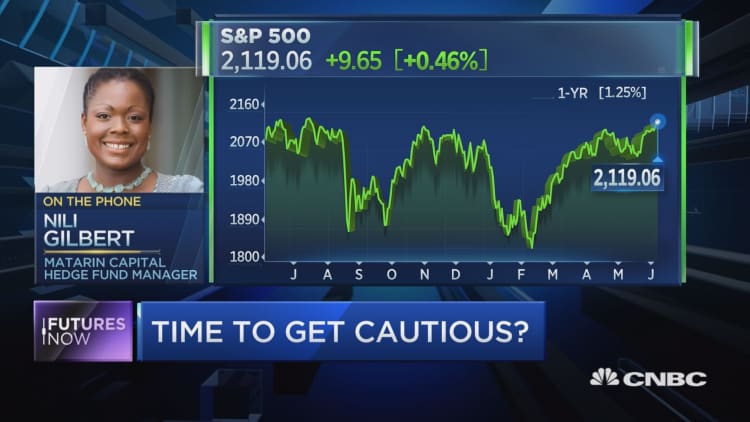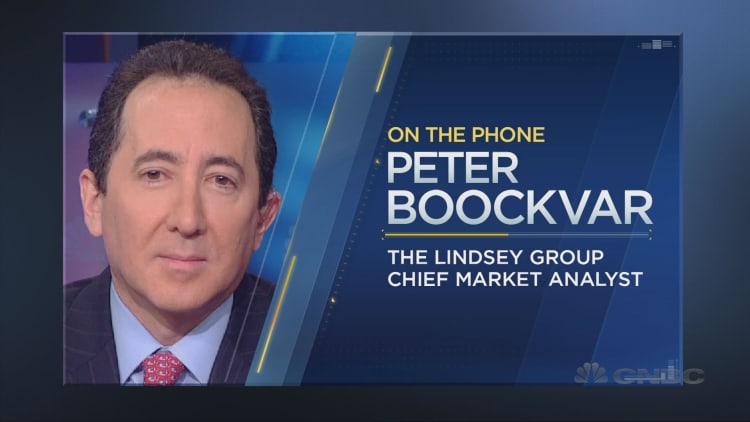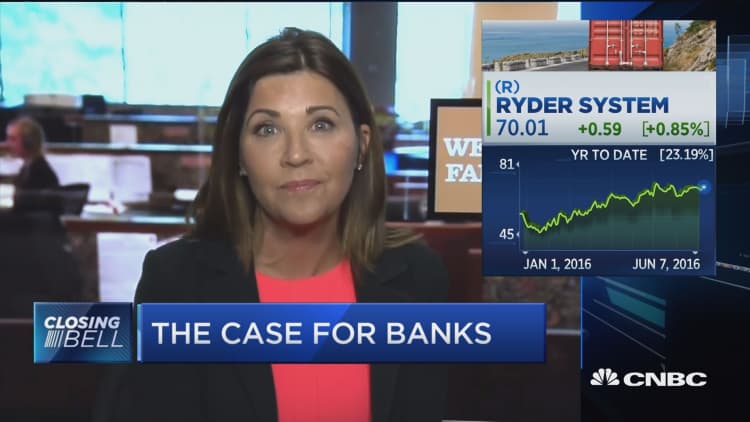


One key for markets Wednesday could be the JOLTs, or job opening and labor turnover survey, an indicator closely watched by the Fed.
The data is expected from the Bureau of Labor Statistics at 10 a.m.
Oil is also a factor, lifting stocks early as West Texas Intermediate futures rose above $51 for the first time since July amid supply disruptions. U.S. inventory data, expected at 10:30 a.m., could also be a factor for the energy market.
There is also the $20 billion 10-year Treasury note auction at 1 p.m. EDT, and with yields in Europe going to record lows, strategists expect a lot of interest in the reopened U.S. 10-year.
For the moment, investors are loading up on both bonds and stocks, with the Fed seemingly sidelined and the European Central Bank rolling out yet another easy-money program Wednesday.
Investors increased wagers Tuesday that the Fed will not raise rates in the near future, while central bank officials await more data to help determine whether the 38,000 jobs reported Friday for May was a fluke or a dire warning for the economy. Fed Chair Janet Yellen spoke Monday and said while the jobs report could be a one-off, the Fed would let data drive its decision.
"Clearly the reaction of both stocks and bonds is consistent with a speech that was read as a very dovish speech. So, they're both up. It suggests the discount factor for both isn't going up anytime soon. If July becomes on the table, they're both going to sell off at the same time," said Robert Sinche, global strategist at Amherst Pierpont.
The markets are also reacting to negative and low yields around the world. The ECB adds corporate bonds to its asset-buying program Wednesday, and that should continue to bring buyers into the U.S., as investors reach for yield.
"Wednesday's 10-year auction will be a more reasonable barometer for overseas interest for Treasuries at these yield levels, and given the global rates backdrop we find ourselves [optimistic] on the prospects for the supply. There is really no domestic data of note on Wednesday, although Chinese trade is on the horizon — yet another in the array of concerns that continue to make the Fed's goal of normalizing rates an elusive one," wrote Ian Lyngen, senior Treasury strategist at CRT Capital.
The ECB corporate-bond-buying program has already had an impact. "What the ECB is doing with this bond-buying program is to reduce the cost of capital for high-yield firms globally," said Steven Wieting, global chief strategist at Citi Private Bank.
The JOLTs number will be watched, because it is a component of the Fed's dashboard, viewed by Yellen as a measure of how much the labor market is tightening. In March, the job-opening rate rose to 3.9 percent, a post-recession high.

"If job openings are still expanding and employment growth slowed down, that would be a scenario that shows the demand for labor is there, and the supply is not available. It's a little dated, but it's an unusually important number," said Sinche. The data are expected to show that there were 5.67 million job openings in April, down from an eight-month high of 5.76 million in March.
Yellen, in her speech, managed to push back rate expectations but leave the door open to rate hikes this year. The Fed's forecast includes two rate hikes this year, so traders are awaiting the Fed meeting next week for guidance on its latest thinking.
"I actually read [Yellen] as being much more hawkish and much more it being a Fed that wants to hike rates, rather than a Fed that doesn't want to hike rates," said Sinche.
Expectations in the Fed funds futures market Tuesday fell to about 20 percent for a July rate hike, an expectation that had been as high as 63 percent before the jobs report. Stocks were mixed, with the S&P 500 rising above a resistance level of 2,111, and taking aim at its May 2015 all-time high of 2,132. The was up 2 at 2,112, while the Nasdaq slid on weakness in biotech and lost 6 to 4,961. Futures were higher Wednesday.
The Fed sensitive yield was at 0.79 percent. But the interesting reaction was in the German bund, where the 10-year yield touched a record low 0.03 percent Wednesday. Traders also said investors are seeking safety in bunds ahead of the U.K. vote June 23 on leaving the European Union. The low yielding bund helped drive buyers into the long end of the U.S. bond market.
Oil prices could also be a factor for markets Wednesday. West Texas Intermediate futures rallied Wednesday, after settling up 1.4 percent to $50.36 per barrel, its first settle above $50 since July 2015. The Energy Information Administration data on oil inventories is expected at 10:30 a.m. EDT.
Wieting said the improvement in oil prices has led him to change his allocations in his midyear outlook.
"This year we're looking to raise exposure to petroleum, and we've done that in multiple asset classes," he said. One area is Latin-American debt, and another is Canadian equities.
"If you look at the last couple of years, investors were prematurely bullish. Last year, petroleum production was still growing while capex was beginning to get cut," he said. "Global exploration activity has fallen 50 percent, and inventories should be the last thing to fall."


